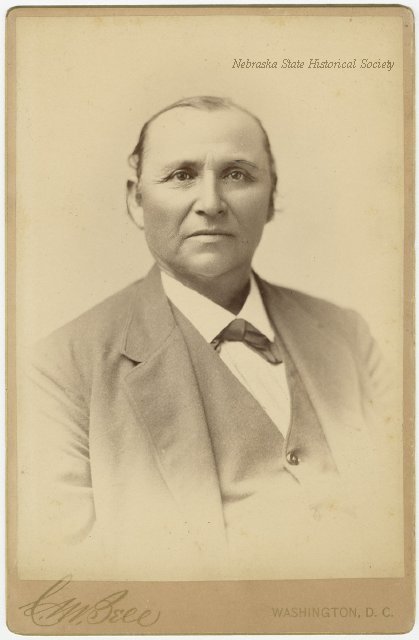Difference between revisions of "Nebraska Historical Marker: Omaha Tribe"
| (2 intermediate revisions by the same user not shown) | |||
| Line 1: | Line 1: | ||
| − | [[Image: | + | [[Image:Iron_Eye.jpg |thumb|center|upright=3.0|alt=Iron_Eye.jpg]] |
==Location== | ==Location== | ||
| Line 6: | Line 6: | ||
View this marker's location '''[https://www.google.com/maps/place/42%C2%B007'08.6%22N+96%C2%B021'20.5%22W/@42.119066,-96.3562462,210m/data=!3m2!1e3!4b1!4m5!3m4!1s0x0:0x0!8m2!3d42.119066!4d-96.355699?hl=en 42.119066, -96.355699]''' | View this marker's location '''[https://www.google.com/maps/place/42%C2%B007'08.6%22N+96%C2%B021'20.5%22W/@42.119066,-96.3562462,210m/data=!3m2!1e3!4b1!4m5!3m4!1s0x0:0x0!8m2!3d42.119066!4d-96.355699?hl=en 42.119066, -96.355699]''' | ||
| − | + | {{Marker:Map}} | |
==Marker Text== | ==Marker Text== | ||
| Line 16: | Line 16: | ||
==Bibliography== | ==Bibliography== | ||
| + | Norma Kidd Green, “The Make-Believe White Man’s Village,” Nebraska History 56 (1975): 242-247 | ||
| − | + | Norma Kidd Green, “Four Sisters: Daughters of Joseph LaFlesche,” Nebraska History 45 (1964): 165-176 | |
| − | + | {{Marker:Program}} | |
Latest revision as of 14:17, 22 January 2018
Location
Main St, Macy, Thurston County, Nebraska
View this marker's location 42.119066, -96.355699
View a map of all Nebraska historical markers, Browse Historical Marker Map
Marker Text
This was the homeland of the Omaha Tribe long before white settlers came to the Great Plains. By 1750, the Omaha occupied a large region in northeastern Nebraska and northwestern Iowa. The name "Omaha" means "those going against the wind or current" and may refer to a traditional migration up the Missouri River by the ancestors of the present tribe. Lewis and Clark, in 1804, recorded that the Omaha lived here and noted the grave of Chief Blackbird. By a treaty in 1854, the Omaha gave up much of their territory, except for the area of the present reservation. The Omaha were a peaceful people who lived by agriculture and hunting. During the trying years in the nineteenth century, they were guided by such forward-looking and influential leaders as Big Elk and Joseph La Flesche (Iron Eye). The tribe never took up arms against the flood of white settlers. A number of Omaha served in Nebraska military units as early as the Civil War. Today, the Omaha people continue to live on their traditional homelands where their ancestors farmed, hunted, and are buried.
Further Information
Bibliography
Norma Kidd Green, “The Make-Believe White Man’s Village,” Nebraska History 56 (1975): 242-247
Norma Kidd Green, “Four Sisters: Daughters of Joseph LaFlesche,” Nebraska History 45 (1964): 165-176
Marker program
See Nebraska Historical Marker Program for more information.
